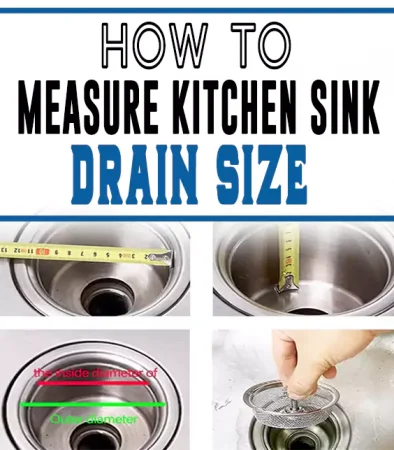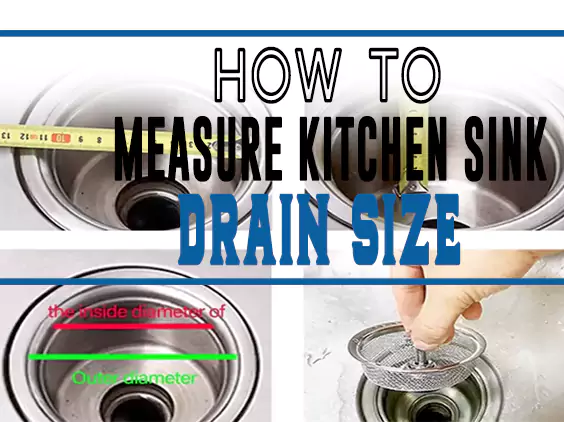When replacing the sink drain or the whole sink, you have to measure the sink drain size. Here’s our guide for four ways for how to measure kitchen sink drain size.
This is important to provide optimal water flow and flush, while also preventing any potential leaks.
That said, if you purchase a new kitchen sink, it might come without a drain assembly kit or instructions.
If you are not familiar with plumbing, this guide will explain how to measure the kitchen sink drain size and how to measure the sink strainer size.
Prepare your measuring tape and check this quick overview of the process.
How to Measure Kitchen Sink Drain Size

Check the instructions that came with the sink
The standard kitchen sink drain hole size is 3-1/2 inches in diameter, 4-inches hole in some cases. This information should be written in the instruction that comes with the sink or drain assembly kit.
Try to contact the manufacturer
If the kitchen sink you’ve purchased came without instructions, you can also try to call or email the manufacturer and ask about the drain size.
Measuring the sink drain with the tape
To check the kitchen sink drain size, take a measuring tape and place it across the center of the drain hole.
That way, you’ll get the maximum width between two opposite points.
This should be the exact size of the drain opening for your sink.
Once you’ve written down the parameters, you can try assembling the strainer to see if it fits.
Check if the strainer fits in the drain hole
Place the strainer in the hole and screw the locknut to see if there is no gap. Don’t forget to attach the gasket using silicone adhesive when putting everything together.
After you’ve measured the kitchen sink strainer and installed it, it’s time to switch our attention to a crumb cup.
How to Measure a Sink Drain Opening for a Crumb Cup
At the first glance, it might seem that any crumb cup will fit the strainer. The truth is that crumb cups can have different forms and sizes.
Step 1: Find the diameter of a drain circle
Use a measuring tape to find out the diameter of a drain circle with the installed strainer.
Like with the sink drain hole, place the tape across the center and write down the size. The next step contains information about the depth of the strainer.
Step 2: Find the depth of the basket
Place the end of the measuring tape closer to its edge right before it meets the slope. Don’t put the measurement tape’s end into the center because the strainer might not fit the entire construction.
The same rule applies when looking for a regular plug instead, which is also known as a stopper. After that, you must learn how to avoid mistakes when buying a crumb cup or a plug.
Step 3: Get a suitable crumb cup or a plug
With the parameters that you’ve just collected, you can go to the nearest store and find a proper crumb cup. Remember to avoid buying a taller model.
This will lead to having a gap between it and a strainer. Thus, the water won’t collect in the sink. Instead, it will go down the tailpipe.
Kitchen Sink Drain Size
When speaking about the kitchen sink drain pipe diameter, the standard kitchen sink drain size is 1-1/2 inches in diameter. This means the hole inside the pipe, not the actual diameter of them.
With older kitchen sink drain pipes, you can come across the 1-1/4-inches diameter. The full size of the pipe is either 2 or 3-1/2 inches.
As for the strainer, they all have a standard size at the top. The pipe that goes inside is much smaller, and it must match the tailpiece’s size. The tight seal is very important to prevent any leaks and ensure optimal connection.
Kitchen Sink Strainer Size
It’s important to get accurate measurements, especially the diameter, as even a small difference can mean the strainer won’t fit properly.
The good news is measuring the size of a kitchen sink strainer is a straightforward process.
First, you need to remove the strainer from the sink. This is usually done by unscrewing it from the drain. If it’s a drop-in strainer, simply lift it out.
Use a measuring tape or a ruler to measure the diameter of the strainer. This is the most critical dimension.
Place the end of the tape or ruler at one edge of the strainer and measure straight across to the opposite edge. Ensure that the tape or ruler passes through the center for the most accurate measurement.
While the depth of the strainer is less critical than the diameter, it’s still good to know. Measure the depth from the top edge of the strainer to its base.
Strainers can be round, oval, or square. Ensure you note the shape, as this will be important when purchasing a replacement or cover.
If the strainer has any unique features, like a specific type of stopper or a unique threading pattern, take note of these as well.
If in doubt, it’s a good idea to take the old strainer with you when purchasing a new one for a direct comparison.
Which Drain Size Do you Need for your Kitchen Sink?
The tailpiece’s size will tell you what pipes you’ll need to look for in the store.
For example, a 2-inch pipe is needed for a 1-1/2-inch drain hole. Alternatively, you’ll want to get a 1-1/2-inch pipe for a 1-1/4-inch hole.
These are the standards used in not only the state you live in but also all around the world. For more information, you’ll need to check the local plumbing codes.
Conclusion
The process of measuring a kitchen sink drain size can be done in several ways as discussed above.
All you need is to grab the measuring tape and follow the mentioned methods. Start with the sink drain hole, then move to the strainer with a crumb cup.

